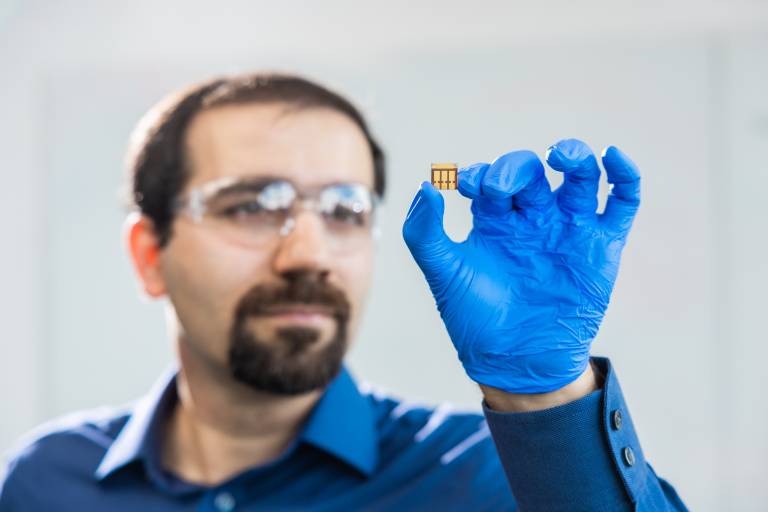
In a world increasingly reliant on billions of connected devices—from smart thermostats to wireless sensors—the demand for small amounts of energy has turned battery replacements into a costly and wasteful routine. Scientists from University College London, in collaboration with partners in China and Switzerland, have developed a groundbreaking solution that could power many of these gadgets indefinitely without the need for battery swaps. Their innovation lies in newly engineered perovskite solar cells, specifically designed to harness energy from everyday indoor lighting with unprecedented efficiency and durability.
A New Take on Solar for Indoor Use
Traditional silicon solar panels are optimized for bright outdoor sunlight, but perovskite cells can be tailored to absorb the softer, narrower range of wavelengths emitted by indoor light sources like LEDs and fluorescents. The challenge has been to make these cells both efficient and stable. Tiny flaws in their crystal structure, known as traps, can snag electrons and waste energy as heat. Over time, these defects also cause the material to degrade, diminishing performance.
The research team, led by Associate Professor Mojtaba Abdi-Jalebi and PhD candidate Siming Huang, addressed this issue using a “Triple Passivation Treatment” (TPT). This involves a carefully selected combination of three chemicals: rubidium chloride, N,N-dimethyloctylammonium iodide, and phenethylammonium chloride. These additives promote more uniform growth of perovskite crystals, reducing internal strain, stabilizing key ions, and preventing the crystals from clumping into separate phases that harm performance. Essentially, they smoothed the path for electrons to move freely, enhancing the cell’s ability to convert light into electricity.
Lead author Siming Huang likened the improvement to fixing a broken cake: “The solar cell with these tiny defects is like a cake cut into pieces. Through a combination of strategies, we have put this cake back together again, allowing the charge to pass through it more easily.”
Efficiency and Durability Set New Records
The results are impressive. Under lighting conditions equivalent to a bright office (about 1000 lux), the cells achieved an indoor power conversion efficiency of 37.6%—a world record for perovskite devices designed for indoor use. This efficiency is approximately six times greater than the best commercial indoor solar cells currently available.
Equally significant is their durability. In storage tests at room temperature and low humidity, the cells retained 92% of their performance after more than four months. Even under harsher conditions—continuous light at 55°C for 300 hours—they maintained 76% of their initial output. In contrast, comparable untreated devices dropped to less than half of their starting performance.
Powering the Internet of Things Without Batteries
The implications are vast for the rapidly expanding Internet of Things. As senior author Dr. Mojtaba Abdi-Jalebi notes, “Billions of devices that require small amounts of energy rely on battery replacements – an unsustainable practice. This number will grow as the Internet of Things expands.” With these high-efficiency cells, small electronics in homes, offices, and factories could draw steady power from ambient light without human intervention.
The manufacturing process offers additional advantages. Perovskite cells can be produced using abundant materials at relatively low temperatures and even printed in a process similar to newspaper production. This combination of scalability, low cost, and high efficiency has led researchers to engage in active discussions with industry partners about commercializing the technology. If successful, these cells could redefine how we power small electronics, transforming ambient light into a continuous, maintenance-free energy source.
Past Studies and Findings
Previous research on indoor photovoltaics explored organic semiconductors and dye-sensitized cells, but these technologies often suffered from lower efficiencies and shorter lifespans compared to the latest perovskite designs. Early generations of perovskite indoor solar cells showed promise but were plagued by rapid degradation due to ion migration and crystal defects, with operational lifespans measured in weeks or months.
3D tomography images of element (Pb+ and Rb+) and molecular ion (DMOA+, PEA+, FA+, and MA+) distributions in a target perovskite thin film on the FTO glass substrate. (CREDIT: Advanced Functional Materials)
Researchers have also experimented with varying the bandgap of perovskites to better match indoor light spectra, achieving modest gains in performance. However, stability has remained a persistent challenge, limiting their commercial viability.
Practical Implications of the Research
This breakthrough could enable a new class of self-sustaining electronics, from environmental sensors and security alarms to medical monitoring devices. Without the need for frequent battery changes, this technology could lower maintenance costs, reduce e-waste, and improve sustainability. It may also support innovation in smart homes and industrial automation by enabling continuous operation of devices in locations where battery replacement is impractical.
In the long run, indoor light harvesting could play a role in building-wide energy efficiency strategies, where every lumen of artificial light serves a dual purpose—both illumination and power generation. The research findings are available online in the journal Advanced Functional Materials.







